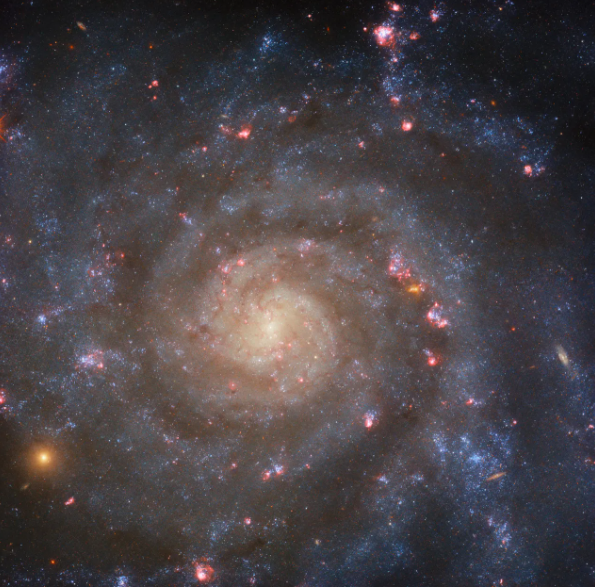NASA's Hubble Space Telescope has recently provided a captivating view of the spiral galaxy IC 5332, situated approximately 30 million light-years away in the constellation Sculptor.
This galaxy has an almost face-on orientation to Earth. Visualizing a spiral galaxy similar to an immense disk, a "face-on" perspective implies that it appears circular and disk-like from our terrestrial viewpoint.
According to NASA, this differs from an "edge-on" orientation, where the galaxy seems compressed and oval-shaped. Recognizing that the same galaxy can exhibit vastly different appearances contingent on whether it is observed face-on or edge-on from Earth is crucial.

The face-on spiral galaxy IC 5332 has been photographed by NASA's Hubble Space Telescope.
SABc-Type Galaxy
IC 5332 is categorized as a SABc-type galaxy in the De Vaucouleurs system of galaxy classification. The "S" designation signifies its classification as a spiral galaxy, evident from its well-defined arms adorned with luminous stars and dusky dust formations extending outward from the galaxy's bright and densely packed core.
The "AB" classification is slightly more intricate, indicating that the galaxy is mildly barred, referencing its central structure. Unlike galaxies that radiate from a single point, most spiral galaxies emanate from an elongated bar-shaped structure.
SAB galaxies, also termed intermediate spiral galaxies, lack a distinct bar-shaped core but do not originate from a single point either, falling somewhere in between.
The lowercase "c" delineates the degree of coiling exhibited by the spiral arms, and "a" would denote tightly wound, while "d" suggests loosely wound. Hence, IC 5332 is an intermediate spiral galaxy on several fronts: weakly barred, with relatively loosely wound arms, and almost entirely face-on.
Read Also: Starry Pair: NASA's Hubble Captures Stunning Portrait of Spiral Galaxies Resembling Milky Way
Barred Spiral Galaxy
In a parallel revelation, NASA's Hubble Space Telescope offers a glimpse of vivid expanses of bright pink and deep red, embellishing the foreground of the barred spiral galaxy NGC 5068.
Initially cataloged by British astronomer William Herschel in 1785, this celestial wonder is located in the southern region of the Virgo constellation, roughly 20 million light-years distant, with an estimated diameter of around 45,000 light-years.
In the upper central region of the image, NGC 5068 showcases a prominent central bar characterized by a dense concentration of mature stars. Behind this bar, a gravitational behemoth in the form of a black hole exerts its compelling force, drawing stars into its grasp.
Radiant pinkish-red regions along the lower and lateral sections denote zones of ionized hydrogen gas, serving as the cradle for burgeoning star clusters.
While partially obscured from this viewpoint, these blotches trace the galaxy's spiral arms, where budding stars commonly form. Within NGC 5068, astronomers have identified no fewer than 110 Wolf-Rayet stars.
These colossal, aging celestial entities undergo rapid mass shedding. Typically eclipsing our sun's mass over 25 times and outshining it by up to a millionfold, Wolf-Rayet stars number around 220 in our Milky Way.
Related Article: NASA Hubble Discovers Saturn's Ring System Heats Planet's Atmosphere-A Never-Before-Seen Phenomenon!









